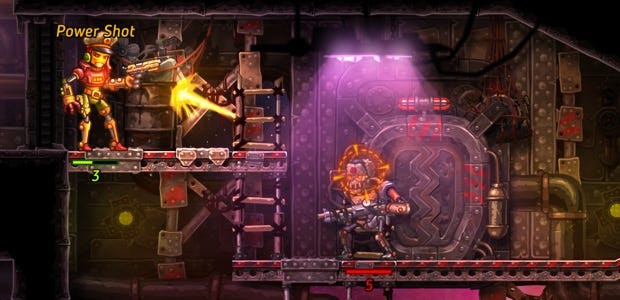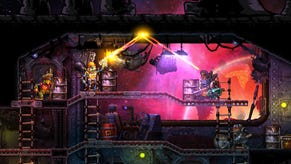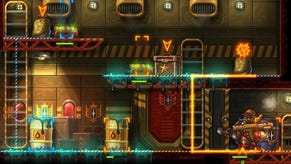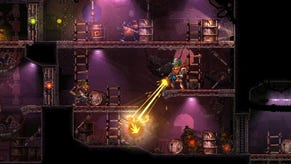How SteamWorld Heist brought skill into turn-based tactics
No more dice rolls
This is The Mechanic, where Alex Wiltshire invites developers to discuss the inner workings of their games. This time, SteamWorld Heist [official site].
SteamWorld Heist is a tactics game about boarding procedural spaceships with a squad of desperado robots and grabbing all the swag you can before they’re turned to scrap. It’s also a cross-genre oddity, a turn-based platformer, with presentation and polish that comes across a bit like a Nintendo fan fell in love with XCOM.
But while that observation is essentially true and it’s a big part of Heist’s rust-bucket charm, it ignores the real reason why it’s so great. And the reason why SteamWorld Heist so great? It’s down to a single simple-sounding feature:
THE MECHANIC: Realtime aiming
So yes, developer Image & Form loves Nintendo. They started out making games for Nintendo’s DS and 3DS handhelds with SteamWorld Tower Defense and SteamWorld Dig, and Heist originated on 3DS, too. But Heist feels just as at home on PC, perhaps partly because it was directly inspired by XCOM, and more specifically its expansion, Enemy Within.
“We were having lunch at work one day, with everyone gathered around the table talking about it,” says creative lead Olle Håkansson. “We were simply blown away how much was improved from the original, especially with the new Meld system. Still, as the discussion went on, we realised the expansion still had some of the kinks left from the original game.”
They loved how hard XCOM is. They loved how its difficulty gives every choice gravity; that it makes you care about every decision. But they didn’t like the randomness in XCOM’s chance calculations. Lots of people don’t. You can take multiple consecutive shots with 90% chance of hitting, and chance being chance, come away with every one missed and your squad being wiped.
Chance being chance, that’s fundamentally fair, but it doesn’t feel like it. “And the core of the problem is that those situations are the unavoidable byproduct of a system that rarely or never give you a 100% chance to hit,” says Håkansson. Over that lunch the team began to think and wonder how it could be improved. “And it suddenly hit us. Why don’t we make a game like XCOM, but replacing the dice-rolling with manual aiming?”
With the completion of SteamWorld Dig, a great Motherlode-inspired platformer about digging for resources so you can upgrade to dig further, Image & Form had a hankering to make a strategy game. So they decided to take their experience with platformers and take a swing at strategy.
In practice, the realtime aiming concept works somewhat similarly to how it does in the excellent Valkyria Chronicles. Both involve a degree of skill in achieving the hit you’re looking for, and yet in Heist the effect is much more deliberate. Valkyria Chronicles’ bullets and rockets still have a chance of missing, with range and the type of weapon affecting their spread, but Heist’s weapons fly true to how you aim them, and get the extra effect of a twist that rewards creative strategies and taking risks.
That twist was ricochets, a chance to reach awkwardly placed targets with insane-looking skillshots. They found the best part of their first prototype was aiming weapons with laser sights and watching the trajectory line bounce off the walls. “You’d try to find the perfect angle for hit hard-to-reach targets, often using multiple walls to your advantage,” says Håkansson. But they found weapons without laser sights were fun, too, because of the sheer reward for hitting a far-off target with an unguided shot.
But the prototype also highlighted some more problematic consequences of realtime aiming. For one thing, it was obvious that if a bullet was going to be bouncing around, boxy architecture was a no-no. So sloped floors and ceilings, as well as platforms that you could shoot through, came to the fore.
They also noticed that the system rather encouraged what Håkansson calls “stale fine-tuning”, where you’d spend ages carefully lining up the exact shot and then execute it. They wanted to promote skill and timing instead, so they added a sway to the aim using a noise function rather than a sine curve so it’d be unpredictable.
“This added some randomness to the equation, but only for the more extreme cases,” he says. “You’ll have to really screw up to miss a point-blank shot. But you’ll have a chance to score outrageous long distance hits, and you can influence your outcome by being very careful in your aiming and timing. I’m very happy with how this turned out, where there’s enough randomness to spice up the game, but without being overly reliant on it.”
And then there was implementing cover, a major element in XCOM and a natural addition to Heist. But it presented a big technical challenge because the team wanted cover to be damaged by bullets. The first implementation of the bullet system would calculate its trajectory before you pulled the trigger, and one benefit of approach was that the laser sight would exactly match what would happen when you fired.
On the other hand, if the level changed as a result of a shot, such as cover being destroyed, the original calculation would suddenly look nonsensical, since the bullet would bounce between a wall and thin air. Image & Form tried destroying the bullet if it hit cover so it didn’t bounce off it. “We eventually realised that this was siphoning the fun out of the game, often soaking up the bullets in an otherwise awesome firefight,” Håkansson says. They tried delaying the destruction of the cover until the end of the bullet’s flight, but that looked pretty confusing.
“In the end, we choose to just simulate the projectile as it went. It made things a bit more complicated, but it was very much worth it in the end,” he says. “This relatively simple change made the game significantly more fun to play. It was very much one of those ‘Why didn’t we just do it this way from the beginning?’ moments.”
Playing the final game, you’re quickly aware of how the aiming system lends its weapons their characters. There are the sharpshooters’ scoped guns, for which you get to see a long trajectory but don’t allow moving and firing in a single turn. There are grenade launchers, which show only the start of their parabola so they don’t quite give away the perfect angle to lob a grenade into a group of enemies at a distance. Weapons with short sights are balanced against those with long ones by being able to do more damage and through having interesting properties, like penetrating bullets.
There was still one more issue, one that Image & Form worried about a lot when it began production on Heist, and one that many players worry about when they start the game, too. It’s the issue of lining up a shot when your character and the target are too far apart for them to be on the screen at the same time. “That was a tough one,” says Håkansson, but he and the team eventually let it go. Once you’re familiar with Heist, you know that at those distances you’re more at the whims of the swaying aim. “It’s less of a problem for the game than intuition calls for,” says Håkansson, and besides that, it’s even more rewarding if you can score a hit when you’ve had to extrapolate the exact line.
There are two great demonstrations of how successful the aiming system turned out. First, there’s hat collection. This game within the game, which allows you to collect enemies’ hats if you can cleanly shoot them off their heads, is all about precision and risk-taking, since any shot that doesn’t score damage on an enemy might well expose your steambots to its return fire on its turn.
And there’s melee. “We tried adding some melee weapons to the mix as well, but they turned out to be less satisfying to use,” says Håkansson. “In the end, only one character in the game focuses on melee combat, but he’s badass enough to get away with it.” (That would be Billy Gill.) A big reason why melee doesn’t feel as good as aiming a gun is that it’s an assured hit. There’s no frisson of uncertainty, where the deliberate positioning of your steambot butts up to a test of your skill.
It’s easy in tactics games to overlook the importance of suspense amongst all the certainties of strategic calculation. And when the suspense is levelled at your own ability, allowing you to take strategic risks that rely on getting a critical headshot. “We got to reduce the amount of randomness without making the game feel stale,” says Håkansson. “In my opinion it kept the feeling of suspense and strategic choice that makes this genre so engaging.”






















